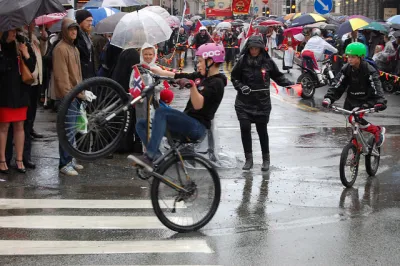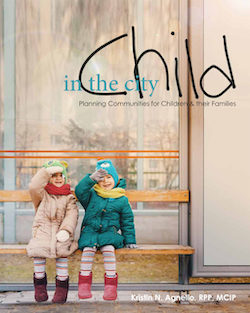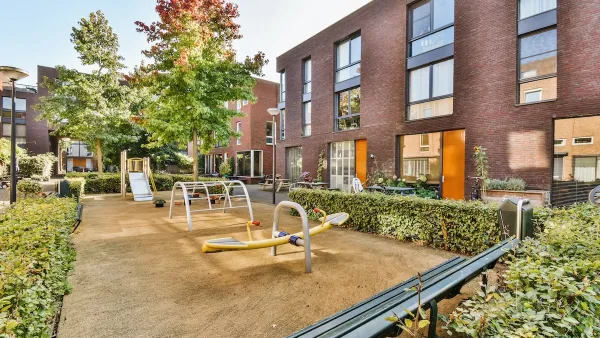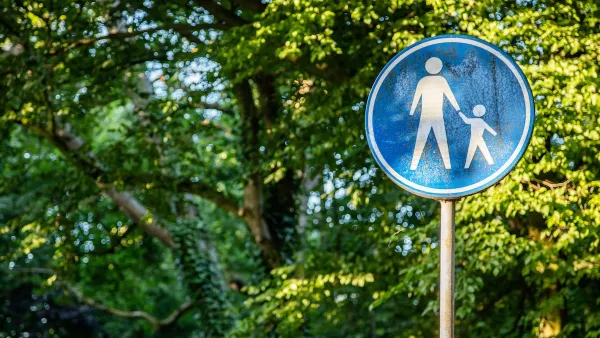Child in the City asks “If you could see the city from an elevation of 95 cm, what would you do differently?” It provides a toolbox of specific policies and planning practices for creating more child-friendly communities.

A new book by Kristin N. Agnello, Child in the City: Planning Communities for Children & their Families [pdf], asks, “If you could see the city from an elevation of 95 cm, what would you do differently?”
The book provides a toolbox of specific policies and planning practices for creating more child-friendly communities, primarily oriented toward existing urban neighborhoods rather than greenfield development.
Agnello emphasizes that environments that addresses the needs of children—who have limited independent mobility, experience, and autonomy—are friendlier and more accessible to people of all ages and abilities. This toolkit has been developed collaboratively, with voluntary input from local governments, nonprofit housing organizations, architects, urban designers, urban planners, developers, real estate specialists, researchers, and educators. This toolkit is not intended to exclude adults and seniors, but rather provide a lens through which planners, designers, and policy-makers can support child and family-friendly development practices that have positive intergenerational benefits. To plan cities in a way that enables children to be co-authors of their own communities is key to a sustainable—and inclusive—future. If the city tells a story of experience, opportunity, and ownership, then its design should enable all citizens to write their own story.
This guidebook emphasizes the value of mixed-use and mixed-income neighborhoods with diverse and affordable housing, local services for families with children (stores, schools, parks, etc.), convenient and comfortable pedestrian and bicycling conditions, plus community safety. It includes checklists of local policies for family-oriented communities.
Here is a summary of child-oriented urban design features:
- Children need opportunities to join a loose social group of other children without a formal—or prearranged—invitation to play.
- Children need access to safe, uninhibited outdoor play to support their physical and mental health. Outdoor play should include opportunities to interact with the natural environment—finding bugs, smelling flowers, playing in puddles, or collecting objects—without the need for excessive rules, oversight, or segregation.
- Children need environments that are safe from traffic, pollution, and undue physical or social hazards, including safe routes to and from school and local playgrounds, allowing them to travel throughout their neighbourhoods safely in order to develop confidence, resilience, and independence.
- Children need private spaces for themselves and their friends, including tree houses, forts, or clubhouses that are close to home yet away from public view. 5.
- Children need stable, appropriate, and affordable housing that provides them with private space to rest, study, and play.
- Children need local access to appropriate early childhood education, child care, and community schools.
- Children benefit from the opportunity for their parents to work locally.
- Children benefit from walkable communities, with infrastructure for safe walking, cycling, and recreation.
- Children benefit from diverse, multi-generational communities, where they can interact with—and learn from—children, adults, and seniors of all races, religions, cultures, and incomes.
- Children should be given an opportunity to effectively and productively participate in decision-making processes.
FULL STORY: Child in the City: Planning Communities for Children & their Families [pdf]

Analysis: Cybertruck Fatality Rate Far Exceeds That of Ford Pinto
The Tesla Cybertruck was recalled seven times last year.

National Parks Layoffs Will Cause Communities to Lose Billions
Thousands of essential park workers were laid off this week, just before the busy spring break season.

Retro-silient?: America’s First “Eco-burb,” The Woodlands Turns 50
A master-planned community north of Houston offers lessons on green infrastructure and resilient design, but falls short of its founder’s lofty affordability and walkability goals.

Test News Post 1
This is a summary

Analysis: Cybertruck Fatality Rate Far Exceeds That of Ford Pinto
The Tesla Cybertruck was recalled seven times last year.

Test News Headline 46
Test for the image on the front page.
Urban Design for Planners 1: Software Tools
This six-course series explores essential urban design concepts using open source software and equips planners with the tools they need to participate fully in the urban design process.
Planning for Universal Design
Learn the tools for implementing Universal Design in planning regulations.
EMC Planning Group, Inc.
Planetizen
Planetizen
Mpact (formerly Rail~Volution)
Great Falls Development Authority, Inc.
HUDs Office of Policy Development and Research
NYU Wagner Graduate School of Public Service





























